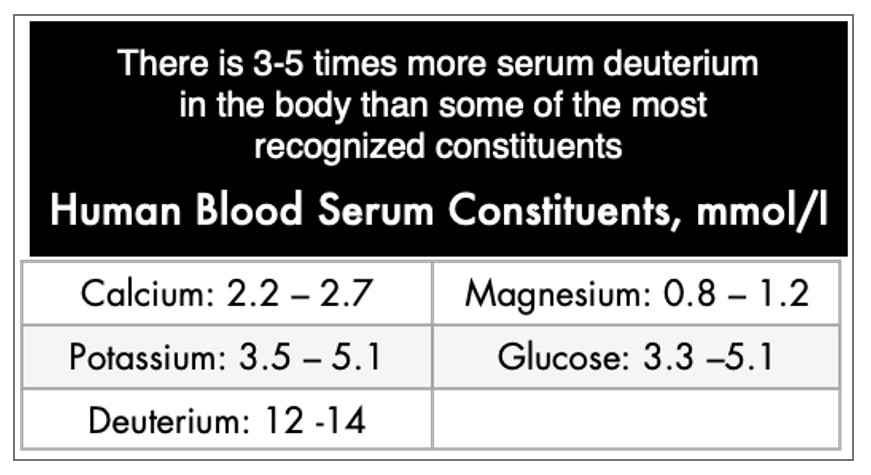by Victor Sagalovsky
Health and medical professionals are astounded when they first hear about a ubiquitous, yet barely acknowledged water molecule, that can be every bit as toxic as heavy metals. This remarkable story chronicles the 60 years of scientific investigation into the biology of deuterium that is finally coming to the forefront of health and medicine.
Hidden in plain sight is a small percentage of water molecules containing deuterium—a rarely mentioned isotope of hydrogen. It is one of three hydrogen isotopes, the others being protium and tritium. But there’s nothing new about deuterium—it goes back to the beginning of the universe. Only now is its significance in the biology of all living things being recognized and understood worldwide.
The Cosmic Beginning
In the first fractions of a second following the Big Bang, 13.8 billion years ago, was the creation of protons and neutrons followed by their interaction with electrons. The result was the most overwhelmingly abundant element in the universe, hydrogen, as its three isotopes: protium, deuterium and tritium.
Over billions of years of the expansion of the Universe, the first elements were generated in the sustained fusion of stars and supernovas and distributed throughout vast space. Element attracted element…cosmic dust formed…then asteroids comets, planets and moons….
The elements hydrogen and oxygen chemically reacted, generating interstellar H2O—liquid water, water vapor, and ice (first, a protium or deuterium H-isotope joined to oxygen forming OH, then another H-isotope joined the OH, forming H2O). Eventually, about 4.5 billion years ago, a long-lasting event known as the Late Heavy Bombardment brought most of the water to Earth in the form of icy comets and asteroids (some water was generated by chemical reactions within the crust of the Earth).
Back on Earth
Deuterium is present in virtually all water on Earth. There are about six drops (150 ppm of deuterium-containing water molecules in each liter of water. There are noteworthy anomalies in Nature due to the meteorological redistribution of the protium and deuterium H-isotopes. The most significant example is the deuterium content of snow and ice in Antarctica—89 ppm, nearly half the deuterium level of the Earth’s water sources, including the oceans.
Fast forward more than 13 billion years to 1932 when Harold C. Urey and his colleagues Ferdinand G. Brickwedde, and George R. Murphy at Columbia University proved the existence of deuterium as a stable H-isotope with a mass of 2 (the protium H-isotope has a mass of 1). Deuterium had gone undetected by physicists perhaps because it only made up 0.0149% of all hydrogen in the universe. Some suspected the existence of this twice-as-heavy H-isotope as early as 1913. Urey was hot on its trail.
Ushering in the Atomic Age
In 1934 Dr. Urey won the Nobel Prize in chemistry for this monumental discovery of deuterium that would usher in the atomic age. Concentrated deuterium (in the form of heavy water) was the missing piece needed for nuclear reactors and the making of atomic bombs. Because of deuterium, our world would never be the same.
While the 1930s brought a paradigm shift in physics, much was the same with biology. In 1929, ATP (adenosine triphosphate), the fuel of all life, was discovered. This came 39 years after the discovery of mitochondria, the powerhouse of the cell in which ATP is generated. In 1937, some of the mysteries of mitochondria were unraveled, especially the mechanisms of ATP production. But science would have to wait another 60 years before the detrimental effects of deuterium on ATP production and the biology of all living things would be understood.
Shortly after Dr. Urey proved its existence in 1933, his mentor, Gilbert N. Lewis, a professor of chemistry at Berkeley University, was the first to create pure heavy water using the electrolysis of water. Professor Lewis was also the first to observe that when concentrated heavy water was frozen, it sank instead of floated like normal water. He also observed how it strongly delayed the reproduction of microbes and retarded the growth of germinating seeds.

Between 1933 and 1939 there were 216 published English language studies on the biological effects of deuterium, all arriving at the same observation: that heavy water was an impairment on key biological processes. The experiments replacing normal water with just 30% heavy water caused bacteria, plants, and animals to die in a matter of days.
As World War II approached, heavy water became increasingly difficult to obtain for further study as countries were hoarding production in preparation for making nuclear reactors and atomic bombs. Biological research on deuterium was thus stifled and gradually faded away until the 1950s.
The Modern Chapter on Deuterium Begins
About the same time that Francis H.C. Crick and James D. Watson announced the double-helix structure of DNA in 1953, a gerontology and genetics graduate student named Gennady D. Berdyshev at the University of Tomsk in Siberia (Soviet Union) was urged to investigate a very peculiar anomaly concerning lifespans of the Soviet population. While the average percentage of centenarians in all of the Soviet Union was about 8 per one million, in certain mountainous areas of Siberia there were an astounding 324 centenarians per one million. Furthermore, most of this population of Altai and Yakutia enjoyed great health and vitality well into their old age.
Knowing that these regions were supplied with glacial melt water from high altitudes, he was motivated to investigate this factor as a possible common denominator of health and longevity of their inhabitants. Scientists focused on the possibility that some unique and unrecognized water characteristic might be involved—a mystery hidden perhaps in ancient glacial ice.
The first experiments consisted of mining permafrost at a depth of 20 meters and melting water that had existed as ice for 300 million years. In the lab, they observed how this water stimulated cell division and slowed down cellular aging. When the institute could no longer pay for the extraction of ancient ice, they evaluated Siberian snow from their own vicinity and to their surprise it had the same effects. The theory of deuterium-depleted water was beginning to take shape.
The experiments done by V.M. Muhachev at the Tomsk University in 1959 to 1960 convinced his colleagues that even a small dose of deuterium distorted the chemistry of hydrogen bonding and inhibited sub-molecular processes. By 1960 Berdyshev had enough information to conclusively link the health and longevity of the Yakuts and the Altaians with the consumption of glacial melt water. The researchers from Tomsk further discovered that ancient ice, high latitude mountain snow, and glacial runoff were 15-20% depleted in deuterium compared to what became known as the Vienna Standard Mean Ocean Water (VSMOW), which is 155.76 ppm of deuterium-containing water at the equator.
In 1966 Rodimov and his biophysics department chair, I.V. Toroptsev, were allowed to publish their work in English for the benefit of researchers and scientists everywhere. With their groundbreaking findings in Biological Role of Heavy Water in Living Organisms1 they put Tomsk University on the map, becoming the very first scientists to show how water depleted in deuterium had a positive biological effect. Considering that deuterium had only been discovered 30 years before, this was a monumental breakthrough. Possibly, one of the great secrets of health and longevity had just been revealed!
Coincidentally around the same time, one of the greatest discoveries in biology was taking shape by Paul D. Boyer, a molecular biologist at UCLA. He discovered that tiny protein nano-motors within the mitochondria, sitting at the end of the Electron Transport Chain (ETC) provided a key step in producing ATP. These protein assemblies, spinning at a rate estimated to be 9000 RPM, have the structure and function of an electro-mechanical motor, complete with rotor, stator, and magnetic field. Boyer christened these nanomotors “ATP Synthase.” But it would be another 40 years, and the turn of the millennium, before deuterium’s damaging effect on ATP Synthase would be discovered.
Biological Effects of Deuterium
By the 1960s it was clear that deuterium, having twice-the-mass of its lighter isotope protium, could be responsible for profound biological and biochemical effects. After all, no other element on the periodic table has isotopes differing in mass to this extreme degree. An understanding of how deuterium functions at the cellular level was now on the horizon.
While Russian scientists were doing their research and making quiet breakthroughs, Americans were also hot to blaze a deuterium trail. It was 1963 when John F. Thomson of the medical research division of Argonne National Laboratory in Chicago wrote the definitive 152-page treatise entitled “Biological Effects of Deuterium.”2 In 1966, the work of his colleagues Joseph J. Katz and Henry L. Crespi reinforced the biological implications of deuterium, noting in “Deuterated Organisms Cultivation and Uses,”3 that deuterium affects the shape of proteins and the replication of DNA.
Laboratory mice experiments were conducted in which their normal body water was altered in the percentage of heavy water, yielded the following observations:
- Experiment #1: Laboratory mice body water was increased in concentration of heavy water to 30%. It proved to be fatal to the mice in a matter of days.
- Experiment #2: Laboratory mice body water was depleted in deuterium by 30% (105 ppm) and resulted in significantly increased lifespan.
Nearly a decade later in 1974, again at Argonne National Labs, British scientist T.R. Griffiths, at the 2nd International Conference on Stable Isotopes, proposed the theory that deuterium might be the primary cause of aging. In Possible Roles of Deuterium in the Initiation and Propagation of Aging and Other Biochemical Mechanisms and Processes,4 he reported that deuterium, being twice as heavy, more electronegative and having different atomic binding properties than regular hydrogen, interfered with DNA replication. Because DNA repair enzymes contain deuterium in a position that is normally occupied by protium, they have a potential for triggering DNA replication and repair errors.
The following year, in 1975, J.D. Gleason and I. Friedman, replicating the Russian findings on plant growth, published the first American study on using deuterium depleted water to increase the growth of grains. This small but significant publication in Nature5 magazine paved the way for a new generation of scientists to try and understand more deeply the function of deuterium in the biology of all living things.
Maintaining Health and Slowing Down Aging
When the Hunza people of northern Pakistan were investigated for their robust health and increased longevity, it was determined that the deuterium content of their water, from the glaciers of Mt. Ultar, was about 133 ppm, a deviation of 16% from the 155 ppm global reference for equatorial ocean water. A 16% reduction may not seem significant, however there are two factors that are in play.
One is that the Hunza population is provided with this deuterium depleted water from birth to death and their vegetable, grain and fruit produce, as well as the animals they raise also are depleted in deuterium. Two, Griffith had reason to postulate that the adverse biological effects of deuterium is “proportional to the square of the concentration.” This is the reason why researchers report that even a small depletion of deuterium has a significant biological benefit.
By the 1990s pivotal research was being furthered in Romania and Hungary. W. Bild and colleagues at the Romanian University of Medicine and Pharmacology showed that mice exposed to a sub-lethal dose of 8.5 grays of radiation had a greater survival rate on deuterium-depleted water. Mice consuming water that was reduced to 30 ppm of deuterium had a 61% survival rate whereas the control group consuming plain tap water (150 ppm) had a survival rate of only 25%. The test group also maintained normal white blood cell and red blood cell platelet counts as compared to the control group which did not.
The same two groups of unfortunate rodents were also infected with pneumonia and the test group showed an intensification of immune defenses not seen in the control group. The scientists concluded that mice with lower levels of deuterium in their systems would benefit from fewer cell division errors and more effective repair of radiation-damaged DNA. It was proof yet again that deuterium-depleted water had some unknown and seemingly magical positive biological effect. Note: These animal tests were carried out for the sole purpose of evaluating the effects of deuterium depletion for patients undergoing chemotherapy.
The growing reported evidence from researchers, along with the work of Hungarian Nobel-prize winner Albert Szent-Györgyi, inspired the work of Gábor Somylai, a doctor and molecular biologist. In 1991 he engaged in the most extensive clinical trials of the physiological benefits of deuterium depletion ever conducted. His findings were published in 1998 in the paper “The Biological Effects of Deuterium Depletion”6 and his 2001 book Defeating Cancer.7
Somylai’s double-blind clinical trials first demonstrated that deuterium-depleted water was free of any side effects and, that the survivability of his test group on deuterium-depleted water was significantly better than those cancer patients in the control group. He also showed that consuming deuterium-depleted water was an excellent complementary adjuvant to conventional radiation and chemotherapy.
Between October 1992 and the spring of 1999, Dr. Somylai and his team administered some 350,000 liters of deuterium-depleted water (DDW) to approximately 1,200 patients, generating over 12,000 pages of documented records. His groundbreaking work put Hungary on the map as an important center for research on the emerging health science of deuterium depletion.
By the beginning of the 21st century, it was well understood among researchers that consumption of deuterium-depleted water (DDW) protected DNA from damage—but it was not understood how. It was only a matter of time until this mystery would be solved.
In 2006, Russian chemist Igor A. Pomytkin and his colleague O.E. Kolesova published the study “Relationship between Natural Concentration of Heavy Water Isotopologues and Rate of H2O2 Generation by Mitochondria.”8 They were able to show that whatever cellular mechanism is susceptible to heavy water deuterium damage and, in turn, is protected by deuterium-depleted water (DDW) was located within the mitochondria. Scientists now understand that mitochondria have an inherent biological strategy for keeping cellular water free of deuterium—as the water inside the inner membranes of mitochondria has 60-70% less deuterium than extracellular water.
The Great Biological Discovery
The following year, 2007, marked the occasion of the most monumental discovery in the short history of deuterium science. Abdullah Olgun, PhD, a medical doctor, biochemist, and pharmacologist from the Department of Biochemistry and Clinical Biochemistry at Gülhane School of Medicine in Ankara, Turkey published the paper “Biological Effects of Deuteronation: ATP Synthase as an Example.”9 His pioneering research showed for the first time how deuterium caused its damage in Complex Five of the electron transport chain, inside the ATP Synthase nano-motor.
Dr. Olgun determined that roughly every 15 seconds a bare heavier deuterium nuclei (a proton – neutron pair), impinges upon the fast spinning nano-motor, causing it to jam, stutter, and ultimately self-destruct. Dr.Olgun further explained in his paper “Deuteronation and Aging,“10 published the same year in the Annals of the New York Academy of Science, that mitochondrial damage resulting from deuterium is one of the primary causes of physical aging. The mystery of how deuterium damaged life was finally revealed! The Nobel Prize worthy significance of Abdullah Olgun’s findings may be hailed as one of the greatest biological discoveries of the 21st century and the absence of recognition of his achievement stands as a careless oversight in the annuls of science.
At that time of Dr. Olgun’s groundbreaking discovery, few scientists realized the gravity of his breakthrough. One notable person that did was Anton Chernopiatko, a Russian businessman, scientist and deuterium depletion enthusiast who also co-authored with Pomytkin the 2015 study “Deuterium Content of Water Increases Depression Susceptibility: The Potential Role of a Serotonin-Related Mechanism.”11
Having embraced the importance of deuterium-depletion from an early age, a lifelong quest was ultimately put into action. Chernopiatko, now having definitive proof of the role of deuterium as a biological Trojan horse, took it upon himself to advance deuterium-depleted water production technology beyond laboratory and research purposes and construct a factory to produce it on a commercial scale.
Whereas Berdyshev in the 1990s had created an industrial process for reducing deuterium by 30-40% using a refrigerated process, it was around 2003 that the first vacuum-assisted fractional-distillation rectification column, exclusively for the production of deuterium-depleted water, was developed at the Institute of Fine Chemical Technologies in Moscow. This efficient process could remove 95% or more of the heavy water deuterium. In 2012, Chernopiatko began construction of a plant in the Russian countryside commercializing the technology developed at the Institute in Moscow. Five years of advanced engineering, trial and error, and good old elbow grease yielded the first dedicated facility in the world to continuously produce 90%+ deuterium-depleted water (DDW).
It is 2020; the mechanisms of deuterium and how to remove it are well understood. Nevertheless, the awareness of this colossal discovery is still in its infancy. Four international conferences on deuterium depletion in Budapest have provided a place for scientists to present their work.
One scientist keen on advancing the work is Laszlo Boros, MD, and professor at UCLA who is leading the charge in the new field of deutenomics. The objective of this new science is to understand how deuterium is managed by biological systems. According to Dr. Boros, “The structured water pool of the (cellular) cytoplasm can thus be considered as a ‘deuterium scavenging water tank’ that absorbs deuterium from carbohydrates and amino acids in order to protect mitochondrial ATPase nanomotors from breaking, among other functions!”12
The New Age of Deuterium Depletion
As of this writing, there are three primary producers of deuterium-depleted water, Preventa in Hungary, Qlarivia in Romania, and Vividi in Russia, which is offered in the United States by Litewater Scientificunder their “Litewater” brand. This exclusive deuterium-depleted water (DDW) is notable for its 94-97% reduction of deuterium—the lowest in the world. Only time will tell how this new scientific revelation of deupletion (deuterium depletion) will impact health and longevity of mankind. So far, the science and its application to health and medicine show much promise.
This article was originally published in Townsend Letter (January 2021).
For more information on deuterium-depleted water and cancer, see Petra Davelaar Dorfsman’s article in the January 28, 2023 edition of Townsend E-Letter.
References
- Toroptsev L, et. Al. Biological Role of Heavy Water in Living Organisms, Questions of Radiobiology and Hematology, publishing house of Tomsk University, 1966.
- Essen C. Biological Effects of Deuterium. Yale Journal of Biology and Medicine. 1964 Aug; 37(1): 99
- Katz J, Crespi H. Deuterated Organisms Cultivation and Uses. Science. March 11, 1966:151 (3715): 1187-1194.
- Griffiths TR. Possible Roles of Deuterium in the Initiation and Propagation of Aging and Other Biochemical Mechanisms and Processes. Proceedings of the second international conference on stable isotopes, Argonne National Lab., Ill. (USA); p. 3-18; 1975
- Gleason J, Friedman I. Oats may grow better in water depleted in oxygen 18 and deuterium. Nature. 1975; 256: 305.
- Somylai G. The Biological Effects of Deuterium Depletion, a possible new tool in cancer therapy, Zeitschrift fur Onkologie. January 1998.
- Somylai G. Defeating Cancer. 2002. ISBN-13: 978-0759692619
- Pomytkin I, Kolesova O. Relationship between Natural Concentration of Heavy Water Isotopologues and Rate of H2O2 Generation by Mitochondria. Bulletin of Experimental Biology and Medicine. December 2006; 142(5):570-2
- Olgun A. Biological Effects of Deuteronation: ATP Synthase as an Example. Theoretical Biology and Medical Modeling. 2007; 4: 9.
- Olgun A, et al. Deuteronation and Aging. Annals of the New York Academy of Sciences. April 18, 2007.
- Strekalova T, et al, Deuterium content of water increases depression susceptibility: The potential role of a serotonin-related mechanism. Behavioural Brain Research. January 15, 2015;277, 237-244
- Boros L, et al. Submolecular regulation of cell transformation by deuterium depleting water exchange reactions in the tricarboxylic acid substrate cycle. Med. Hypotheses. 2016; 87: 69–74
About the Author
Victor Sagalovsky is the co-founder of Litewater Scientific. He is an author, scientist, and teacher. Currently, Victor has directed his efforts to advancing the health, anti-aging, and longevity benefits of deuterium depletion and the production and distribution of Litewater DDW.



